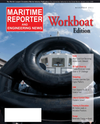
Page 41: of Maritime Reporter Magazine (November 2011)
Feature: Workboat Annual
Read this page in Pdf, Flash or Html5 edition of November 2011 Maritime Reporter Magazine
November 2011www.marinelink.com 41ity, crew endurance, safety and comfort, and ability to carry out tasks?designedinto them.Training the crews of high-speed boats has evolved,? Close said. ?We need to make our crews proficient, not just qual- ified. Once they qualify, they need to go out and practice in all conditions, day andnight, low visibility, and heavy seas. Close said that fathometers do not work well as a navigational tool at higher speeds. Also, high-speed boats can ?out- run their radar,? he said. ?We have come to rely on electronic navigation, but in a dynamic high-speed environment you need to look out the window as well.? High speed has brought about a cultureshift in the boat operations chain of com-mand. A new dedicated navigator posi- tion has been added to the coxswain and engineer. The entire crew is involved in a risk assessment prior to getting under- way. ?All the crew members have to agree on the different aspects of risk in- volved. It?s no longer just the coxswain deciding to get underway.? he said. Commercial high-speed vessels share all the same human factors issues that the Coast Guard is concerned about with itsown boats. ?No matter how fast it goes, it?s still a vessel, and it has to comply with all the rules of the road,? Close said. ?Concerns related to training, crew en- durance, visibility limitations and com-peting waterway users for example apply to all high-speed vessels.? Dr. Tony Armstrong from Austal, based in Henderson, Western Australia, also de- livered a keynote address. He discussed the trimaran hull design now being em- ployed for fast ferries and for naval ap- plications, as well as the benefits of all-aluminum ship construction. Arm- strong shared Austal?s experience with the all-aluminum Westpac Express, Hawaii Super Ferry, Benchijigua Ex- press, Littoral Combat Ship, and the JointHigh Speed Vessel (JHSV). In addition to aluminum, the delegates heard from a number of experts who dis- cussed the relative merits of different ma- terials for high-speed vessels, to include steel, composites, fabric, and titanium. TRANSFORMATIONAL CRAFT Dr. Al Skolnick and Bob Wilson dis- cussed the Office of Naval Research Transformable Craft Innovative Naval Prototype, better known as T-Craft, which can self-deploy without a payload up to 2,500 nautical miles unrefueled at aspeed of 20+ knots through sea state 5;meet up with a sea base; embark up to750 tons of cargo, including vehicles as large as M1A1 tanks, in high sea states; and then deliver that payload to the shore at high speed (more than 40 knots).Three different T-Craft concepts have been developed. The three competing de- sign efforts were led by two American companies (Alion Science and Technol- ogy, and Textron Marine Systems) and one Norwegian company (Umoe Man- dal). ?While long legs and high speed were viewed as doable, transferring cargo at sea and delivering it to the beach feet dry was a bigger challenge,? Wilson said. ?The Navy asked industry, ?Can you do this.? The response was, ?Yes, this is achievable.? There are technologies and systems engineering developments that are needed, but this is a doable thing,? said Wilson. ?It could be built today.? T-Craft merges three unique ship con- cepts?the catamaran, surface effect ship and air cushion vehicle?to deliver long range, high speed, large payloads and the ability to go up onto the beach ?feet dry?and offload cargo. MR Nov.11 # 5 (34-41):MR Template 10/27/2011 10:08 AM Page 41

 40
40

 42
42
